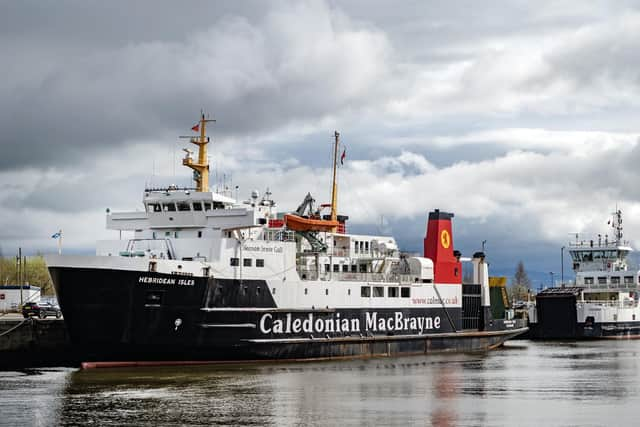Ferries Scotland: Former Scottish Government adviser calls for 'simpler' ferries and shorter routes to fix 'appalling' productivity
A former Scottish Government adviser has called for the use of simpler ferries, with smaller crews on shorter, more frequent crossings as he accused operator CalMac of overseeing “appallingly poor productivity”.
Consultant Roy Pedersen, who previously worked as head of community, culture and transport at Highlands and Islands Enterprise, urged ministers to adopt a “Norwegian model” to combat the ferry network’s “long-standing malaise”.
Advertisement
Hide AdAdvertisement
Hide AdThe suggested model would involve deploying economical vehicle ferries with minimal “live-ashore” crewing on high frequency schedules, and shortening some of the crossing routes. Mr Pedersen pointed towards Shetland’s internal ferries system as a successful example.


The Government has previously announced its intention to directly award the contract for the Clyde and Hebrides network to the publicly-owned CalMac operator. But Mr Pedersen urged the Government to “un-bundle” the routes on the network and allow other firms to submit bids.
He also pushed for operators to bring their own vessels to the routes, which he said would “wholly remove the need for government capital funding of vessels, bringing a saving of an average of perhaps a further £50 million per annum”.
This move would effectively shutter the Government’s publicly-owned ferry procurer Caledonian Maritime Assets Limited (CMAL), which the report claims should eventually be “wound up”.
In a 36-page submission to a Transport Scotland consultation on its Island Connectivity plan, Mr Pedersen highlighted routes such as Port Appin–Lismore, Craignure–Oban, and Islay to Jura as crossings that could be significantly shortened.
He wrote: “Persisting with the current and manifestly dysfunctional policy of the state procuring large, inefficient ships, manned by large live-aboard crew complements, operating on longer routes than necessary, running to overly complex labour-intensive terminals, will increase the already high financial cost to the Scottish taxpayer. This will reduce funding that could otherwise go to financially strapped health and education services while diminishing the well-being of the island communities served.”
Mr Pedersen added: “All this will not happen without capable and informed ministerial direction and leadership. It will require a steady political nerve, but the prize will be greatly improved connectivity to enable our island and remote peninsular communities to flourish, while freeing up large sums of precious taxpayer funds to support Scotland’s struggling public services.”
CalMac’s battle to cope with a major shortage of ships has been intensified by one of its older vessels, the MV Caledonian Isles, being out of action until mid summer or longer to carry out £5 million of substantial steelwork repairs.
Advertisement
Hide AdAdvertisement
Hide AdDuncan Mackison, the interim chief executive of CalMac, said: “Everyone at CalMac is committed to providing a quality and reliable ferry service and this is reflected in our reliability and punctuality figures, which consistently remain at more than 95 per cent and improved in the last financial year.
“However, we fully share customer concerns regarding cancellations and disruptions and are working closely with third parties and stakeholders to address these issues, whilst also investing record sums in our ageing fleet to maintain resilience.
“This investment in maintenance grew to well over £43m in 2023 compared with just £20m in 2017.”
Mr Pedersen, who has appeared repeatedly before Holyrood committees to discuss ferries, also weighed in on the long-running “fiasco” of the two late and over-budget ferries being built at Ferguson Marine in Port Glasgow.
The running political sore could have been avoided, he said, had CMAL opted to commission two 98-car catamarans from an Australian-based yard – at a cost of £12m each – or a similar design, which would “be more economical to operate and have superior sea-keeping, manoeuvrability and environmental qualities”.
Glen Sannox, which is being built at Port Glasgow, was due in service in 2018, but this is not now expected until late July at the earliest. Sister vessel Glen Rosa, which was launched last week, is not due to be completed until next year.
The Government is still to award a contract to build seven smaller ferries to address the unreliability of CalMac’s ageing fleet, with the GMB union having described the need for a decision as urgent.
A Transport Scotland spokesperson said: “The Scottish Government is investing in our ferry services and delivering six new major vessels to serve Scotland’s ferry network by 2026. We have invested more than £2 billion in our ferry services since 2007 and have outlined plans to invest around £700 million in a five-year plan to improve ferry infrastructure and benefit our island communities.
“We want to ensure that transport connectivity to our islands is reliable, affordable and inclusive to support the economic and population growth of these communities.”
Comments
Want to join the conversation? Please or to comment on this article.